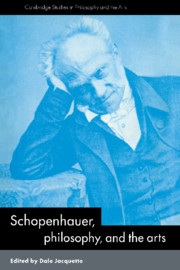Book contents
- Frontmatter
- Contents
- List of contributors
- Editor's acknowledgments
- List of abbreviations
- 1 Schopenhauer's metaphysics of appearance and Will in the philosophy of art
- PART I The work of art: Schopenhauer on the nature of artistic creation
- PART II The experience of beauty: Schopenhauer's theory of aesthetic encounter
- 5 Pleasure and knowledge in Schopenhauer's aesthetics
- 6 Schopenhauer and aesthetic recognition
- 7 Schopenhauer on beauty and ontology
- 8 Schopenhauer, Heidegger, art, and the will
- PART III Schopenhauer's enduring influence on the arts: idealism and romanticism
- Bibliography of selected sources on Schopenhauer's aesthetics
- Index
8 - Schopenhauer, Heidegger, art, and the will
Published online by Cambridge University Press: 05 May 2010
- Frontmatter
- Contents
- List of contributors
- Editor's acknowledgments
- List of abbreviations
- 1 Schopenhauer's metaphysics of appearance and Will in the philosophy of art
- PART I The work of art: Schopenhauer on the nature of artistic creation
- PART II The experience of beauty: Schopenhauer's theory of aesthetic encounter
- 5 Pleasure and knowledge in Schopenhauer's aesthetics
- 6 Schopenhauer and aesthetic recognition
- 7 Schopenhauer on beauty and ontology
- 8 Schopenhauer, Heidegger, art, and the will
- PART III Schopenhauer's enduring influence on the arts: idealism and romanticism
- Bibliography of selected sources on Schopenhauer's aesthetics
- Index
Summary
INTRODUCTION
The question of the relationship between Schopenhauer and Heidegger has been, in English at least, virtually untouched. This is somewhat odd given the evident fact that Heidegger read Schopenhauer and the rather striking affinities between the two. No doubt this neglect has been encouraged by the fact that Heidegger's explicit references to Schopenhauer are, almost without exception, contemptuous. (For example: “[Schopenhauer's discussion of art] stumbles about aimlessly … It cannot be called an aesthetics that would be even remotely comparable to that of Hegel. In terms of content Schopenhauer thrives on the authors he excoriates, namely Schelling and Hegel. The one he does not excoriate is Kant. Instead he thoroughly misunderstands him.”) This, however, should by no means be taken as decisive. Wittgenstein, for example, having plundered, almost plagiarized, Schopenhauer in the Tractatus later judged (employing, paradoxically, a characteristically Schopenhauerian metaphor) that “where true depth begins Schopenhauer's runs out.” And Nietzsche, of course, having plundered Schopenhauerian philosophy in The Birth of Tragedy spent the rest of his life protesting that Schopenhauer has always been his “antipode.”
To speak of the influence of Schopenhauer on Heidegger raises difficult questions concerning the genesis of Heidegger's ideas which, on this occasion, I do not wish to investigate. I shall speak, therefore, merely of affinities. In this essay I propose to begin (but by no means complete) the task of studying the affinities between Heidegger and Schopenhauer. In particular, I want to look at those which concern a topic crucial to both philosophers, the relationship between art and the will.
- Type
- Chapter
- Information
- Schopenhauer, Philosophy and the Arts , pp. 162 - 180Publisher: Cambridge University PressPrint publication year: 1996
- 3
- Cited by



